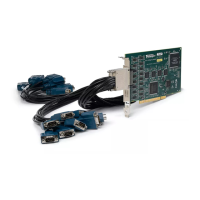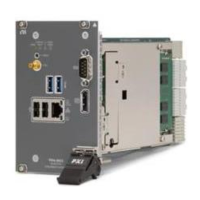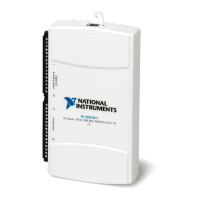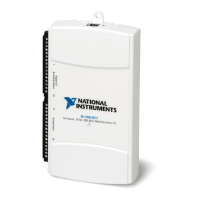Chapter 9 Bus Interface
E Series User Manual 9-2 ni.com
standard implementation for CompactPCI does not include these
sub-buses. The PXI E Series device works in any standard CompactPCI
chassis adhering to the PICMG CompactPCI 2.0 R3.0 core specification.
PXI-specific features are implemented on the J2 connector of the
CompactPCI bus. The PXI device is compatible with any CompactPCI
chassis with a sub-bus that does not drive the lines used by that device. Even
if the sub-bus is capable of driving these lines, the PXI device is still
compatible as long as those pins on the sub-bus are disabled by default and
never enabled.
Caution Damage can result if these lines are driven by the sub-bus. NI is not liable for any
damage resulting from improper signal connections.
Data Transfer Methods
There are three primary ways to transfer data across the PCI bus: Direct
Memory Access (DMA), interrupt request (IRQ), and programmed I/O.
Direct Memory Access (DMA)
DMA is a method to transfer data between the device and computer
memory without the involvement of the CPU. This method makes DMA
the fastest available data transfer method. National Instruments uses DMA
hardware and software technology to achieve high throughput rates and to
increase system utilization. DMA is the default method of data transfer for
DAQ devices that support it.
Note DAQCard devices do not support DMA.
Interrupt Request (IRQ)
IRQ transfers rely on the CPU to service data transfer requests. The device
notifies the CPU when it is ready to transfer data. The data transfer speed
is tightly coupled to the rate at which the CPU can service the interrupt
requests. If you are using interrupts to acquire data at a rate faster than the
rate the CPU can service the interrupts, your systems may start to freeze.
Programmed I/O
Programmed I/O is a data transfer mechanism where the user program is
responsible for transferring data. Each read or write call in the program
initiates the transfer of data. Programmed I/O is typically used in
software-timed (on demand) operations.
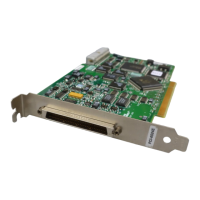
